|
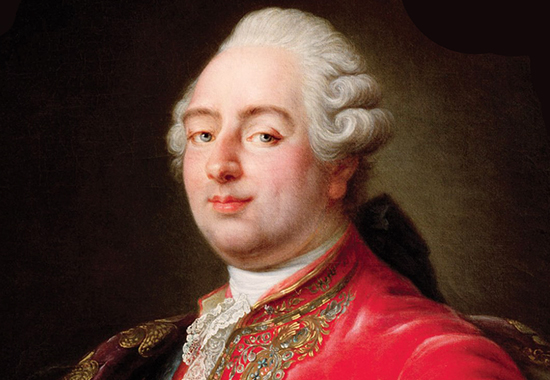
The End of Louis XVI - The End of an Era
Detail from the
painting by Antoine-François Callet, 1786
Musée Carnavalet,
Paris
French
Revolutionary Wars Timeline:
1793
Go here for the
 French Revolutionary Wars
in a Nutshell.
French Revolutionary Wars
in a Nutshell.
January 6, 1793
French
 General Custine suffers defeat
at the
Battle of Hochheim. Here
is the
General Custine suffers defeat
at the
Battle of Hochheim. Here
is the
 battle
map. battle
map.
January 14, 1793
The trial of Louis Capet (formerly King
 Louis XVI)
begins. It will continue until January 20, 1793.
Louis XVI)
begins. It will continue until January 20, 1793.
Today, it was
decided on how to vote (nominal votes, not secret votes) and the
order in which to
proceed with this trial (determine guilt, then an appeal to the people,
then the sentence).
Session opened at 10 AM and finished at 9.30 PM.
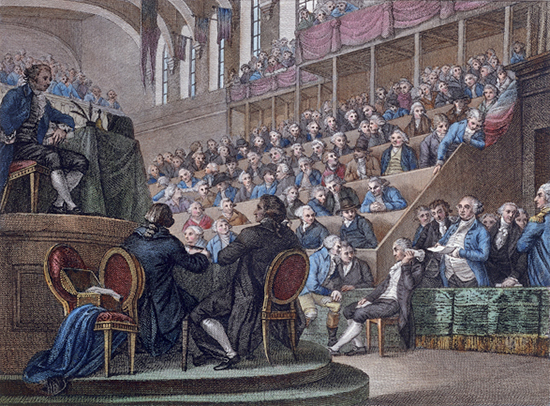
The Trial of Louis XVI
Lithograph by Vinkeles and
Vrydag, 1802
Assemblée nationale
January 15, 1793
Trial of Louis Capet: Today, the chairman (the 40-year-old president
of the National Convention, Pierre
Vergniaud, from the Gironde department) opened session
around 11 AM. It finished at 11 PM.
January 16-17, 1793
Trial of Louis Capet: The marathon session started on January 16 at
10.30 AM and ended on January 17 at 11.00 PM. Today (and yesterday)
Louis' sentence was discussed. For the death penalty voted
387, for detention or death with stipulations voted 334 men.
January 18, 1793
Maximilien Robespierre wants to see more oomph and heartiness in the
decision making. Says he,
To doubt your rights
means to destroy them.
January 19-20, 1793
The trial of Louis Capet (formerly King
 Louis XVI)
ends with 380 to 310 votes in favor of his execution within 24
hours. The chairman announces:
Louis XVI)
ends with 380 to 310 votes in favor of his execution within 24
hours. The chairman announces:
Je déclare, au nom de la Convention
Nationale, que la peine qu'elle prononce
contre Louis Capet est la mort.
In other words:
I hereby declare, on behalf of the National
Convention, that the sentence pronounced
against Louis Capet is death.
And here are the
 minutes of the trial, including
the names of each deputy and the sentence they voted for.
minutes of the trial, including
the names of each deputy and the sentence they voted for.
January 21, 1793
Execution of
 Louis XVI at Paris.
Louis XVI at Paris.
January 23, 1793
The Second Partition of Poland is signed by Russia and
Prussia.
January 24, 1793
Britain orders the French ambassador to London, the
Marquis de Chauvelin, to leave
the country within eight days.
France: Creation of the
 Army of the Coasts. Commander:
La Bourdonnaye.
Army of the Coasts. Commander:
La Bourdonnaye.
January 30, 1793
British
 Horatio Nelson is the new
commander of the HMS Agamemnon.
Horatio Nelson is the new
commander of the HMS Agamemnon.
February 1, 1793
France declares war on Great Britain and the United
Provinces.
February 4, 1793
The new French Defense Minister is
Pierre de Riel de Beurnonville.
He succeeds Jean-Nicolas Pache.
February 6, 1793
Ligniville is the new commander
of the
 Army of the Moselle.
Army of the Moselle.
February 9, 1793
Biron is the new commander of
the
 Army of Italy.
Army of Italy.
February 17, 1793
Great Britain declares war on
France.
February 20, 1793
Riots in the Vendee.
The
 Wars of the
Vendee begin.
Wars of the
Vendee begin.
March 1, 1793
Austrian counter-offensive begins,
led by the
 Prince of
Coburg.
Prince of
Coburg.
 Battle of
Aldenhoven.
Austrian victory.
Battle of
Aldenhoven.
Austrian victory.
March 2, 1793
The French evacuate Aachen
(Aix-la-Chapelle.)
March 4, 1793
 George Washington, U.S. president since April 30, 1789,
commences his second term and, with
135 words, delivers the shortest
inaugural address at Philadelphia.
George Washington, U.S. president since April 30, 1789,
commences his second term and, with
135 words, delivers the shortest
inaugural address at Philadelphia.
March 7, 1793
Spain declares war on France. In July 1793, Portugal will
sign a treaty with Spain against
France.
March 10, 1793
The Revolutionary Tribunal
is created.
March 11, 1793
The
 Wars of the Vendée
begin.
Wars of the Vendée
begin.
March 12, 1793
 Dumouriez
in open rebellion against the
Convention.
Dumouriez
in open rebellion against the
Convention.
March 15, 1793
The
 Army of the
Vosges is merged into
the
Army of the
Vosges is merged into
the
 Army of the
Rhine. Commander:
Custine.
Army of the
Rhine. Commander:
Custine.
March 17, 1793
The Republic of Mainz (French: République de Mayence, German:
Mainzer Republik) is declared. It is
also called the Rhenish-German Free
State (German: Rheinisch-Deutscher
Freistaat).
In
effect, France just annexed a sweet
chunk of the Rhineland. Here is the
map:
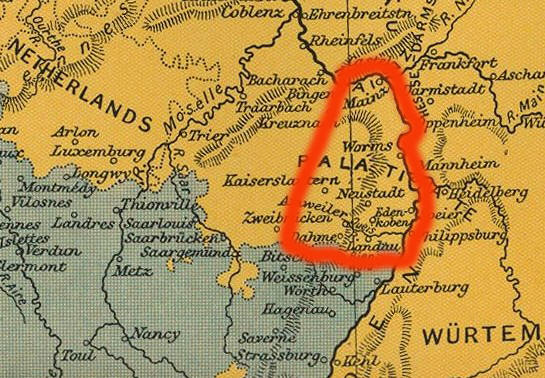
Map of the Approx. Outline of the
Republic of Mainz,
also called the Rhenish-German Free
State
Click
to enlarge
The
Republic of Mainz will end in July
1793.
March 18, 1793
 Battle of Neerwinden.
Austrian victory. Battle of Neerwinden.
Austrian victory.
March 21, 1793
Battle of
Leuven.
Also called
Battle of Louvain. Austrian victory.
The Republic of Mainz (French: République de Mayence, German:
Mainzer Republik) asks to become
part of France. Although Paris is
delighted, this won't happen because
the Germans will be back soon.
March 22, 1793
 Dumouriez
starts negotiations with Austrian
commander
Dumouriez
starts negotiations with Austrian
commander
 Karl Mack von Leiberich.
Karl Mack von Leiberich.
March 23, 1793
The French annex
the Rauracian Republic (République Rauracienne) and
make it one of their departements.
Back in the days, it had been the
Diocese of Basel (Évêché de Bâle).
It became the Rauracian Republic on
November 27, 1792. Now, it is the
departement Mont-Terrible.
Its
name derives from Mont Terri
(Mount Terri).
March 29, 1793
D'Aboville is the new
commander of the
 Army of the
Moselle.
Army of the
Moselle.
April 4, 1793
The new French Defense Minister is
Jean-Baptiste-Noel
Bouchotte. He succeeds
Pierre de
Riel de Beurnonville.
April 5, 1793
 Dumouriez
switches sides and defects to the
Austrians. Big catch for the
Austrians. He had been the French Foreign
Minister when France declared
war on Austria.
Dumouriez
switches sides and defects to the
Austrians. Big catch for the
Austrians. He had been the French Foreign
Minister when France declared
war on Austria.
Dampierre
is the new commander of the
 Army of the
North. He also has
the command over the
Army of the
North. He also has
the command over the
 Army of the
Ardennes.
Leveneur
is the new commander of the Army of
the Ardennes (under Dampierre).
Army of the
Ardennes.
Leveneur
is the new commander of the Army of
the Ardennes (under Dampierre).
Joining Dumouriez in defecting to
the Austrians is
 Louis-Philippe,
who will become King of France in
1830. This will get his father
arrested tomorrow.
Louis-Philippe,
who will become King of France in
1830. This will get his father
arrested tomorrow.
April 6, 1793
The
 Committee of
Public Safety
is created today.
Committee of
Public Safety
is created today.
Louis
Philippe Joseph, aka
Philippe
Égalité, gets arrested
today thanks to his son,
 Louis-Philippe,
who deserted to the Austrians
yesterday. Although Philippe Égalité
had voted for the death of Louis
XVI, this incident changes
everything. He will be guillotined
on November 6, 1793. Louis-Philippe,
who deserted to the Austrians
yesterday. Although Philippe Égalité
had voted for the death of Louis
XVI, this incident changes
everything. He will be guillotined
on November 6, 1793.
April 14, 1793
The Siege of Mainz begins. It will
end on July 23, 1793.
April 15, 1793
The British, led by
Cornelius
Cuyler and
John
Laforey, recapture Tobago
from the French who had occupied the
island since 1781.
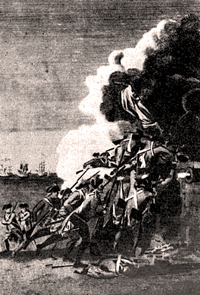
Attack on Fort King George,
Scarborough, by the British — April
15, 1793
Historic Tobago
Trinidad and Tobago Tourist Board
April 22, 1793
The first president of the United
States,
 George
Washington, issues a
formal
George
Washington, issues a
formal
 proclamation of neutrality.
proclamation of neutrality.
France was hoping for ties a little
bit closer than that. But then
again, so was Britain.
April 23, 1793
The Revolutionary Tribunal finds
 Marat
not guilty.
Marat
not guilty.
April 28, 1793
Houchard
is the new commander of the
 Army of the
Moselle.
Army of the
Moselle.
April 30, 1793
D'Ornac
is the new commander of the
 Army of the
Alps.
Army of the
Alps.
The
 Army of the
Coasts is divided
into three armies:
Army of the
Coasts is divided
into three armies:
The
 Army of the Coasts of
Brest (Commander:
Canclaux),
Army of the Coasts of
Brest (Commander:
Canclaux),
the
 Army of the Coasts of
Cherbourg (Commander:
Wimpfen [Wimpffen]),
and the
Army of the Coasts of
Cherbourg (Commander:
Wimpfen [Wimpffen]),
and the
 Army of the Coasts of La
Rochelle (Commander:
Leigonyer
[temp])
Army of the Coasts of La
Rochelle (Commander:
Leigonyer
[temp])
The Army of the
Interior becomes the Army of the Coasts of La
Rochelle.
The
 Army of the Pyrenees
is split into the
Army of the Pyrenees
is split into the
 Army of the Eastern
Pyrenees (Commander:
De Fiers)
and the
Army of the Eastern
Pyrenees (Commander:
De Fiers)
and the
 Army of the Western
Pyrenees (Commander:
Servan).
Army of the Western
Pyrenees (Commander:
Servan).
May 4, 1793
Brunet is the new
commander of the
 Army of Italy.
Army of Italy.
May 8, 1793
Lamarche is the new
commander of the
 Army of the
North. His
post is temporary.
Army of the
North. His
post is temporary.
May 21, 1793
Kellermann is the new
commander of the
 Army of the
Alps.
Army of the
Alps.
May 23, 1793
The Siege of Valenciennes begins.
The allies are led by
 Frederick Duke
of York, who commands
a joint army consisting of his
British forces and part of
Frederick Duke
of York, who commands
a joint army consisting of his
British forces and part of
 Coburg's
Austrian army. Travelling
along and observing is
Coburg's
Austrian army. Travelling
along and observing is
 Metternich. Metternich.
This siege will end on July 28,
1793.
May 27, 1793
Custine is the new
commander of the
 Army of the
North. He also
has the command over the
Army of the
North. He also
has the command over the
 Army of the
Ardennes.
Army of the
Ardennes.
May 28, 1793
Biron is the new
commander of the
 Army of the
Coasts of La Rochelle.
Army of the
Coasts of La Rochelle.
May 29, 1793
Uprisings in Lyon.
May 30, 1793
Alexandre de Beauharnais
is the new commander of the
 Army of the
Rhine.
Army of the
Rhine.
June 2, 1793
Fall of the (Brissotins)
 Girondins.
The moderate Girondins are ousted
from the National Convention.
Girondins.
The moderate Girondins are ousted
from the National Convention.
France
will now experience an intensified
struggle between supporters of the
National Convention (Montagnards,
Sans-culottes, Jacobins) and
supporters of the Girondins
(counter-revolutionaries who soon
will be called Federalists).
Entire
cities, in support of the
Federalists, will break out in open
revolt against the National
Convention government, e.g. Lyon,
Nimes, Toulouse, and Marseille.
June 8, 1793
The British try to isolate France
and issue an
Order-in-Council.
Henceforth, any vessel bringing
flour, corn, or meal to France will
be seized. The next order-in-council
will be issued on
 November 6,
1793, and it will be
a doozie.
November 6,
1793, and it will be
a doozie.
June 11, 1793
The Austrians take Condé.
June 24, 1793
Today, the National Convention approves of the
Constitution of the Year I,
or Constitution of June 24, 1793.
The
National Convention decides to
shelve this constitution for the
moment in order to focus on solving
the war and internal troubles first.
It will never be implemented.
July 5, 1793
La Bourdonnaye is the
new commander of the
 Army of the
Western Pyrenees. His
post is temporary.
Army of the
Western Pyrenees. His
post is temporary.
July 8, 1793
Decree on the organization of relief to be granted annually
to children, the elderly, and the
needy.
July 11, 1793
D'Elbecq is the new
commander of the
 Army of the
Western Pyrenees.
Army of the
Western Pyrenees.
July 13, 1793
Charlotte Corday, a
Girondin, assassinates Montagnard leader
 Jean-Paul Marat in his bath.
Jean-Paul Marat in his bath.
July 17, 1793
Charlotte Corday is
 guillotined. guillotined.
July 23, 1793
The Siege of Mainz ends. It had
begun on April 14, 1793. The French
withdraw. This is the end of the
Republic of Mainz.
July 27, 1793
 Robespierre
becomes member of the
Robespierre
becomes member of the
 Committee of
Public Safety.
Committee of
Public Safety.
July 28, 1793
The
Siege of Valenciennes ends.
Allied victory. This siege had
begun on May 23, 1793.
July 31, 1793
Rossignol is the new
commander of the
 Army of the
Coasts of La Rochelle.
Army of the
Coasts of La Rochelle.
August 1, 1793
An Austro-Prussian army begins the
siege of Landau. They will withdraw
on December 27, 1793.
Kilmaine is the new
commander of the
 Army of the
North. His
post is temporary.
Army of the
North. His
post is temporary.
August 8, 1793
Dumerbion is the new
commander of the
 Army of Italy.
Army of Italy.
August 10, 1793
Lyon is under siege by forces of the
National Convention. The city will
surrender on October 9, 1793.
August 13, 1793
Houchard
is the new commander of the
 Army of the
North.
Army of the
North.
August 17, 1793
Landremont
is the new commander of the
 Army of the
Rhine.
Army of the
Rhine.
August 21, 1793
Battle of
Furnes. (Battle
of Veurne). Victory for
 Lazare Hoche
and the French.
Lazare Hoche
and the French.
August 23, 1793
To kick the fight against
the
 First
Coalition up a notch, the
First
Coalition up a notch, the
 French
National Convention
orders a mass recruitment (levée
en masse) of all unmarried men
and widowers without children
between 18 and 40, and a seizure of
goods for the war effort.
French
National Convention
orders a mass recruitment (levée
en masse) of all unmarried men
and widowers without children
between 18 and 40, and a seizure of
goods for the war effort.
Also on August 23,1793:
The
Siege of
Dunkirchen (Dünkirchen, Dunkirk,
Dunkerque)
begins.
 Frederick Duke
of York was feeling
spunky after having taken Valenciennes.
Against
Frederick Duke
of York was feeling
spunky after having taken Valenciennes.
Against
 Coburg's
advice, he took his men away from
the main Austrian units, arrives at
Rosendael and laid siege to Dunkerque.
Coburg's
advice, he took his men away from
the main Austrian units, arrives at
Rosendael and laid siege to Dunkerque.
This siege
will end on September 8, 1793.
Also on August 23,1793:
In India, the French lose
Pondicherry (Pondichéry). At 9.00 AM
French forces leave the city through
the Villenour gate, while British
forces enter the city through the
Madras gate.
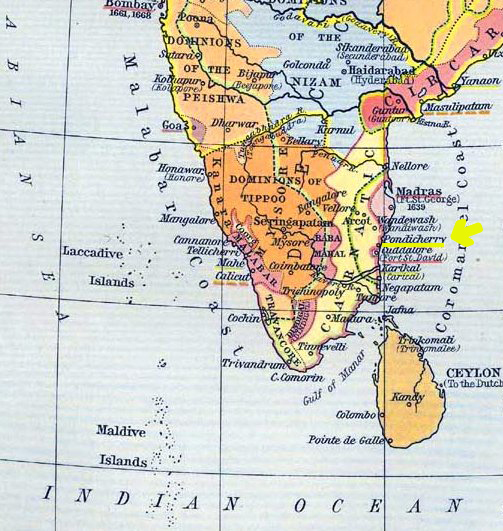
Map Location of Pondicherry (Pondichéry),
Today's Puducherry, southeastern
India
Click
to enlarge
August 25, 1793
Santerre is the new
commander of the
 Army of the
Coasts of La Rochelle.
Army of the
Coasts of La Rochelle.
Troops
sent by the National Convention enter Marseille and crush
anti-government rebels.
August 27, 1793
French
 General Custine
meets the
General Custine
meets the
 guillotine.
guillotine.
French
royalists invite British
Vice
Admiral Lord Hood and
Spanish
Admiral Juan de Langara
and their men to take over the port
of Toulon, a major French naval
base, in order to defeat it against
the French revolutionaries.
August 31, 1793
Rossignol is the new
commander of the
 Army of the
Coasts of La Rochelle.
Army of the
Coasts of La Rochelle.
Després-Crassier (Deprez-Crassier)
is the new commander of the
 Army of the
Coasts of La Rochelle.
Army of the
Coasts of La Rochelle.
September 4, 1793
The commander of the newly created force that will set up the
four-months-long
Siege of
Toulon is
Carteaux.
This force is also called the
Army of
Toulon. Many troops from
the
 Army
of Italy are
transferred to this corps. Army
of Italy are
transferred to this corps.
September 5, 1793
The
 Reign of
Terror officially
begins. (Also called the
Second
Terror. The
Reign of
Terror officially
begins. (Also called the
Second
Terror. The
 First
Terror took
place from August 10 to September
20, 1792.) First
Terror took
place from August 10 to September
20, 1792.)
At today's session at the
Convention Nationale, the
speaker of the Jacobin delegation
who represents all Jacobins from the
48 sections, sets the mood by
shouting out:
Eh bien Législateurs, placez la
terreur à l’ordre du jour !
Well Legislators, make terror the
order of the day !
September 6 - 8, 1793
 Battle of Hondschoote.
French victory. Battle of Hondschoote.
French victory.
September 8, 1793
The Siege of Dunkirchen ends.
 Frederick Duke
of York and his
besiegers had to withdraw with
the quickness when French
General
Jean Nicolas Houchard
was suddenly breathing down
their necks and, simultaneously,
the good people of Dunkirchen,
led by
Frederick Duke
of York and his
besiegers had to withdraw with
the quickness when French
General
Jean Nicolas Houchard
was suddenly breathing down
their necks and, simultaneously,
the good people of Dunkirchen,
led by
 Lazare Hoche,
came out of their city ready to
rumble.
Lazare Hoche,
came out of their city ready to
rumble.
Part of the army withdraws to
Nieuport (Nieuwpoort), where the
French will knock at the town
doors on October 24, 1793.
September 10, 1793
The National Convention decrees the Revolutionary Government
until peace is restored.
Doppet
is the new commander of the
 Army of the
Alps.
Army of the
Alps.
September 17, 1793
The
Law of Suspects
is passed, authorizing the
creation of revolutionary tribunals to
try those suspected of treason against
the Republic and to punish those
convicted with death.
September 18, 1793
Dagobert is the new
commander of the
 Army of the
Eastern Pyrenees. His
post is temporary.
Army of the
Eastern Pyrenees. His
post is temporary.
With
great pomp and celebration,
 George
Washington lays the
U.S. Capitol cornerstone.
George
Washington lays the
U.S. Capitol cornerstone.
September 22, 1793
 Jean
Baptiste
Jourdan
succeeds General Jean Nicolas
Houchard as commander of the
Jean
Baptiste
Jourdan
succeeds General Jean Nicolas
Houchard as commander of the
 Army of the North.
Jourdan has also the command over
the
Army of the North.
Jourdan has also the command over
the
 Army
of the Ardennes. Army
of the Ardennes.
Also
on September 22, 1793:
Battle of
Trouillas (part of the
Roussillon
Campaign) - Spanish
victory over the French. Man of the
day was Spanish
General
Antonio Ricardos y Carrillo.
September 29, 1793
D'Aoust is the new
commander of the
 Army of the
Eastern Pyrenees. His
post is temporary.
Army of the
Eastern Pyrenees. His
post is temporary.
September 30, 1793
Delaunay is the new
commander of the
 Army of the
Moselle. His
post is temporary.
Army of the
Moselle. His
post is temporary.
October 1, 1793
The Army of the Coasts of La Rochelle, The Army of Mainz, and
part of the Army of the Coasts of
Brest are merged and now called the
Army of the West.
October 2, 1793
Carle is the new
commander of the
 Army of the
Rhine.
Army of the
Rhine.
October 5, 1793
The French republican calendar replaces the Gregorian
calendar. It is implemented
retroactively and will be used until
January 1, 1806.
October 6, 1793
Rossignol is the new
commander of the
 Army of the
Coasts of Brest.
Army of the
Coasts of Brest.
The
Army of the
Coasts of La Rochelle,
the Army of
Mainz, and part of the
Army of the
Coasts of Brest (also
called Army
of Nantes) are merged and
now called
 Army of the
West. Commander:
L'Échelle
(or Leschelles or
Léchelle)
Army of the
West. Commander:
L'Échelle
(or Leschelles or
Léchelle)
October 8, 1793
Muller is the new
commander of the
 Army of the
Western Pyrenees.
His post is temporary.
Army of the
Western Pyrenees.
His post is temporary.
October 9, 1793
At noon,
Lyon surrenders to the Republicans.
The city and their
federalist and royalist inhabitants, had been under siege since
August 10, 1793. The commander of
the Lyon's army,
Louis-François Perrin de Précy,
managed to slip away with 1,000 men
and 200 cavalry early this
morning.
October 12, 1793
Turreau is the new
commander of the
 Army of the
Eastern Pyrenees.
Army of the
Eastern Pyrenees.
To
punish and humiliate Lyon for its
disobedience, the National
Convention decrees the destruction
of the city's square Bellecour,
and that the city, or what's left of
it, is renamed Commune-Affranchie
(Liberated Commune).
"Lyon fit la guerre à la liberté,
Lyon n'est plus."
"Lyon made war on freedom, Lyon is
no more."
October 13, 1793
First Battle of Wissembourg
(Weißenburg, Weissenburg).
The
Austro-Prussian army under Austrian
General
Dagobert Sigmund Wurmser
and Prussian
General Charles William Ferdinand
of Brunswick
push the French from the
Weissenburger Linien.
The Weissenburg Lines were famous
entrenchments, constructed by the
Duke de
Villars in 1705 during
the
 War of the
Spanish Succession.
War of the
Spanish Succession.
The French will retake the
Weissenburg Lines at the
Second
Battle of Wissembourg on
December 26, 1793.
October 15 - 16, 1793
 Battle of Wattignies.
French victory. Battle of Wattignies.
French victory.
October 16, 1793
Former
 Queen Marie Antoinette
is Queen Marie Antoinette
is
 guillotined.
guillotined.
October 17, 1793
 Battle
of Cholet.
Victory for French
revolutionaries over French
royalists. This battle is part of
the Battle
of Cholet.
Victory for French
revolutionaries over French
royalists. This battle is part of
the
 Wars of the
Vendee.
Wars of the
Vendee.
October 22, 1793
 Horatio Nelson
and his vessel, the HMS Agamemnon,
encounter French vessels and engage
the French frigate Melpoméne.
Nelson has to retreat.
Horatio Nelson
and his vessel, the HMS Agamemnon,
encounter French vessels and engage
the French frigate Melpoméne.
Nelson has to retreat.
October 24, 1793
The Siege of Nieuport (Nieuwpoort) begins. The French attack
the town but the British troops can
resist.
October 25, 1793
Marseille is recaptured by government troops, the
counter-revolutionaries are crushed. As
punishment,
Fréron decides to
rename Marseille the City Without
a Name.
It
will be Marseille again on
 February 12, 1794.
February 12, 1794.
October 27, 1793
Pichegru is the new
commander of the
 Army of the
Rhine.
Army of the
Rhine.
October 29, 1793
The Siege of Nieuport ends. The French withdraw.
Dours
is the new commander of the
 Army of the
Alps.
Army of the
Alps.
October 31, 1793
Jacques
Pierre Brissot
(leader of the
 Girondins) is
Girondins) is
 guillotined.
guillotined.
Hoche
is the new commander of the
 Army of the
Moselle.
Army of the
Moselle.
November 3, 1793
The new French Defense Minister is
Jean-Baptiste-Annibal
Aubert-Dubayet. He
succeeds
Jean-Baptiste-Noel Bouchotte.
November
6, 1793
Following their
Order-in-Council from
June 8, 1793, Great Britain issues
another one today, which decrees
that "all ships laden with goods the
produce of any colony belonging to
France, or carrying provisions or
other supplies for the use of any
such colony" will be seized.
And
now the kicker: The British will
keep this decree secret until late
December 1794, which will result in
a swift seizure of 250 American
ships by March 1, 1794, and much
anger in the United States. (See
also
 Jay Treaty)
Jay Treaty)
November 16, 1793
Dugommier
is the new commander of the
Army of Toulon (Siege of
Toulon). Its former commander,
Carteaux,
will become commander of the
 Army of the
Alps on November 18,
1793.
Army of the
Alps on November 18,
1793.
November 17, 1793
French
General Houchard ends
his life on the
 guillotine.
guillotine.
November 18, 1793
Carteaux
is the new commander of the
 Army of the
Alps.
Army of the
Alps.
November 22, 1793
D'Aoust is
the new commander of the
 Army of the
Eastern Pyrenees.
His post is temporary.
Army of the
Eastern Pyrenees.
His post is temporary.
November 28, 1793
Battle of Kaiserslautern.
France vs. Prussia. This battle will
last until November 30, 1793.
November 29, 1793
Execution of Antoine Barnave.
November 30, 1793
Battle of Kaiserslautern.
The Prussians, led by the
 Duke of
Brunswick (Karl
Wilhelm Ferdinand,) defeat the
French, led by
Duke of
Brunswick (Karl
Wilhelm Ferdinand,) defeat the
French, led by
 General Hoche.
This battle had begun on November
28, 1793.
General Hoche.
This battle had begun on November
28, 1793.
Doppet
is the new commander of the
 Army of the
Eastern Pyrenees.
Army of the
Eastern Pyrenees.
December 4, 1793
The National Convention confirms the creation of the
Revolutionary Government by passing
the
Law of 14 Frimaire, year II.
December 8, 1793
The
 Marquis de
Sade, currently at
Paris, was arrested (again).
Marquis de
Sade, currently at
Paris, was arrested (again).
December 12, 1793
 Battle of Le Mans.
Victory for French
revolutionaries over French royalists. This
battle is part of the
Battle of Le Mans.
Victory for French
revolutionaries over French royalists. This
battle is part of the
 Wars of the Vendee.
Wars of the Vendee.
December 19, 1793
After 4 months of siege, the
French revolutionaries enter the
city of Toulon. The
Siege of
Toulon is over. Man of
the day is the 24 year-old
 Napoleon
Bonaparte, who will get promoted to
brigadier general for his
performance in this siege.
Napoleon
Bonaparte, who will get promoted to
brigadier general for his
performance in this siege.
At the
beginning of this struggle,
Bonaparte had been a commander of
artillery. He subsequently was
promoted to major (in September) and
to adjutant general (in October).
The
British have to evacuate Toulon and
will focus on Bonaparte's childhood
stomping grounds, the island of
 Corsica.
See
Corsica.
See
 June 15, 1794.
June 15, 1794.
December 21, 1793
D'Aoust
is the new commander of the
 Army of the
Eastern Pyrenees.
His post is temporary.
Army of the
Eastern Pyrenees.
His post is temporary.
December 22, 1793
Battle of
Woerth / Wörth. (Battle
of Froeschwiller / Fröschweiler). French victory
over the Austrians.
December 23, 1793
 Battle of Savenay.
Victory for French
revolutionaries over French royalists. This
battle was part of the
Battle of Savenay.
Victory for French
revolutionaries over French royalists. This
battle was part of the
 Wars of the Vendee.
Wars of the Vendee.
Pellapra
is the new commander of the
 Army of the
Alps.
Army of the
Alps.
Turreau
is the new commander of the
 Army of the
Coasts of La Rochelle.
Army of the
Coasts of La Rochelle.
December 25, 1793
Robespierre's speech before the Convention Nationale:
The goal of a constitutional government is
to conserve the Republic, that of a
revolutionary government is to establish it.
Revolution is the war of liberty against its
enemies. The Constitution is the victorious
and peaceful rule of liberty.
These notions are sufficient to explain the
origin and nature of the laws that we call
revolutionary. Those who call them arbitrary
or tyrannical only want the resurrection of
tyranny and the death of the country.
December 26, 1793
Second Battle of Wissembourg
(Weißenburg, Weissenburg), also
called
Battle of Geisberg. French
generals
Pichegru and
Hoche retake the
Weissenburger Linien from the
Austrians and Prussians.
The
First
Battle of Wissembourg had
been fought on October 13, 1793.
The Austrians and
Prussians pull back to the other
side of the Rhine River. Alsace
is French now.
December 27, 1793
The Austro-Prussian siege of Landau is raised. The siege had
begun on August 1, 1793.
December 28, 1793
French General Charles Pichegru,
commander of the Army of the
Rhine, and French
General
Lazare Hoche, commander
of the Army of the Moselle,
enter Landau. The besieging
Austro-Prussians withdrew after
their defeat at the
Battle of
Wissembourg on December
26, 1793.
Also
on this day:
Thomas Paine is
imprisoned. He will stay behind bars
until November 4, 1794, including.
December 31, 1793
The French
 guillotine their
General Biron.
guillotine their
General Biron.
More History
|